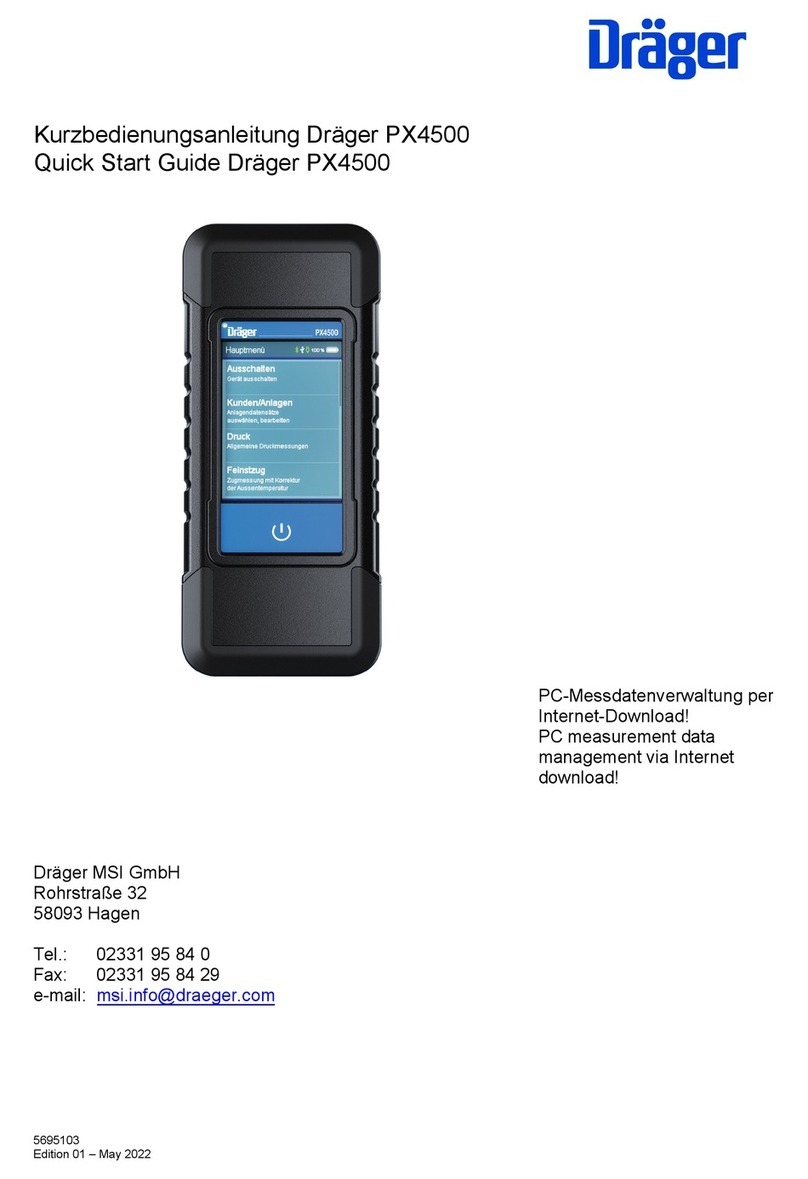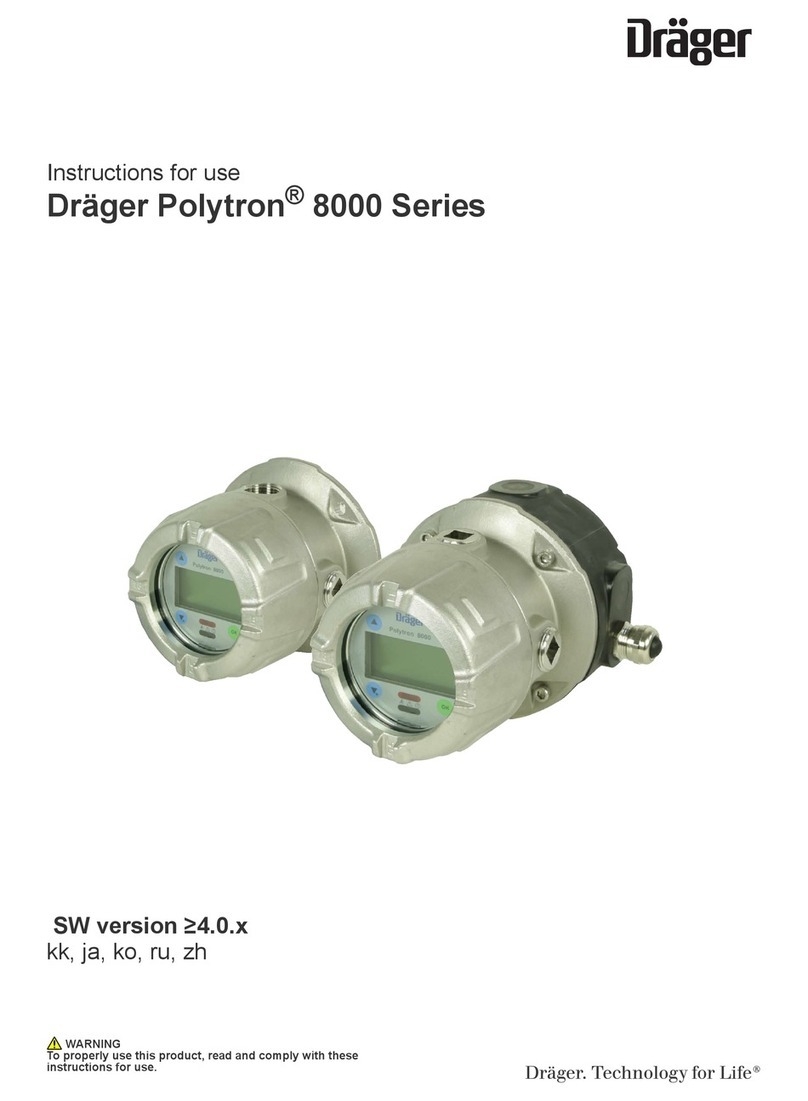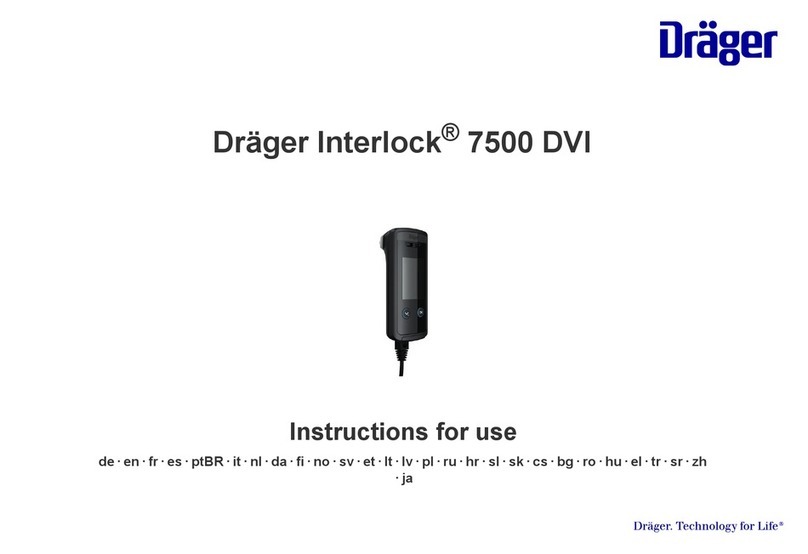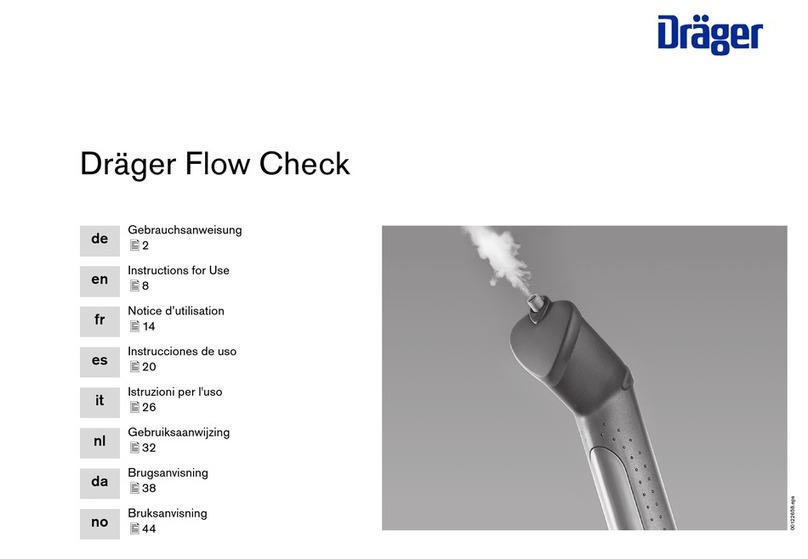5.9 Adjustable operation timer (in days)
— Dräger Pac 3000 is equipped with an adjustable operation
timer. The operation timer can be used to set an individually
operation period e. g. to adjust a "calibration due date", an
"inspection due date", an "out of order date" etc.
— To adjust the operation timer connect Dräger Pac 3000 to a PC
using the connecting cradle or the E-Cal System. The adjustment
can be done with installed software Pac Vision or CC Vision.
6 Alarms
6.1 Concentration Pre/Main Alarms
—
An optical and acoustical alarm are activated whenever alarm
threshold A1 or A2 is exceeded.
The instrument is equipped
with a vibrating alarm. It vibrates in parallel to these alarms.
— During an A1, the LED will blink and the alarm will sound.
— During an A2, the LED and alarm tone will repeat in a double
repeating pattern.
— The display will alternate between the measurement value and
"A1" or "A2".
— The alarms may, according to the selected configuration, be
acknowledged or turned off. (See section 4.) "Acknowledgeable":
alarms and LED can be acknowledged by pressing
[OK]
.
—
"Latching": The alarm will only deactivate when the concentration
falls under the alarm threshold and then
[OK]
is pressed.
— If the alarm is not latching, the alarm will deactivate as soon as
the concentration falls under the alarm threshold.
6.2 Battery pre/main alarms
— When the battery pre-alarm is activated, the audible alarm
sounds and the LED blinks, and the “low battery” icon » «
flashes.
— To acknowledge the pre-alarm, push
[OK]
.
— After the first battery pre-alarm, the battery will last for
approx. 1 further week and the "low battery" icon stays lit.
— When the battery main alarm is activated, the audible alarm
sounds in a repeating pattern of 2 repeating tones and the LED
blinks in the same pattern.
— The battery main alarm is not acknowledgeable; the instrument
will automatically turn off after approx. 1 minute.
— In case of a very low battery, the internal voltage monitor could
activate the LED’s.
6.3 Changing the battery
— Do not change the battery in explosion-hazard areas!
— The instrument contains a replaceable lithium battery.
— The battery is part of the Ex approval.
— Only the following battery types shall be used:
— Duracell 123 Photo, Lithium, 3 V
— Duracell 123 Ultras, Lithium, 3 V
— Panasonic CR 123A, Lithium, 3 V
— Energizer EL 123A, Lithium, 3 V
— Powerone CR 123A, Lithium, 3 V
— Turn the instrument off.
— Unscrew the 4 screws from the back case.
— Open the front case and remove the depleted battery.
— Insert the new battery according to specified polarity (+/–).
— Place front case back and fasten it by tightening the 4 screws of
the back case.
— After changing the battery a sensor warm up time of approx.
15 minutes is needed. The gas name flashes until the warm up
time has passed.
6.4 Handling of exhausted batteries
—Caution:
— Never throw them into a fire!
— Never attempt to charge them!
— Never attempt to open them, danger of explosion!
— Dispose of exhausted batteries only as special waste in
accordance with local regulations.
— Spent batteries may be returned to Dräger Safety for disposal.
6.5 Usable life alarm
— Before the end of the instrument’s usable life, a warning period
begins. During this period the remaining life time flashes just
after turning the instrument on, e. g. "30" / "d".
— To acknowledge this message
[OK]
must be pressed. After that,
the instrument can be used further.
— After the usable life has expired the text "0" / "d" will alternate in
the display and cannot be acknowledged. Dräger Pac 3000 will
not longer measure and may be returned to Dräger Safety for
recycling.
6.6 Instrument alarm
— The alarm and LED will be activated three times, periodically.
—The
[X]
icon is flashing, a 3 digit error code is shown in the
display.
— If an error appears in the display see section 6.7 and if
necessary please contact DrägerService.
6.7 Trouble shooting errors
Code Cause Remedies
100 Flash / EEprom write
fail
Contact DrägerService
102 AD system defect Contact DrägerService
104 Flash check sum wrong Contact DrägerService
107 Self test failed Contact DrägerService
109
Configuration incomplete
Configure again
210
Fresh air calibration failed
Repeat operation
220 Span calibration failed Repeat operation
240 Bump test failed Repeat bump test or
calibrate instrument
7 Technical Specifications
8 Sensor Specifications
_____________
Date of production: see label at the back case.
Environmental Conditions
During opera-
tion
–30 to 50 oC / –22 to 122 oF
700 to 1300 hPa
10 to 90% relative humidity
Conditions for
storage
0 to 40 oC / 32 to 104 oF
30 to 80% relative humidity
Ingress protec-
tion
IP 65
Operating
times
2 years (typical at 25 oC)
Battery life
(typical at
25 oC)
24 hours of use per day,
1 minutes alarm per day:
CO, H2S: >10.400 hours
O2: >3.600 hours
Intensity of
alarm
typical 90 dB (A) at a distance of 30 cm
(11.8 in.)
Dimensions 64 x 84 x 20 (battery compartment 25) mm
2.5 x 3.3 x 0.8 (battery compartment 1) in.
Weight 106 g (3.8 oz.)
Approvals CE0158 (89/336/EEC, 94/9/EC)
DEMKO 04 ATEX
I/II M 1/1 G EEx ia I/IIC T4,
–30
o
C
≤
Ta
≤
+55
o
C (–22
o
F
≤
Ta
≤
+131
o
F)
UL Class I, II Div I, Group A, B, C, D, E, F, G,
Temp Code T4
–30
o
C
≤
Ta
≤
+55
o
C (–22
o
F
≤
Ta
≤
+131
o
F)
cUL Class I, II Div I, Group A, B, C, D, E, F, G,
Temp Code T4
–30
o
C
≤
Ta
≤
+55
o
C (–22
o
F
≤
Ta
≤
+131
o
F)
CO H2S O2
Temperature Influence
Zero point:
≤
±5 ppm no effect
≤
±0.2 vol.-%
Sensitivity:
≤
±0.3 %
of measured
value / K
≤
±5 % of mea-
sured value
≤
±2 % of
measured value
Drift (20 oC)
Zero point:
≤
±2 ppm/a
≤
±1 ppm/a
≤
±0.5 vol.-%/a
Sensitivity:
≤
±1 % of
measured value
/ month
≤
±1 % of
measured value
/ month
≤
±1 % of
measured value
/ month
Please be aware of possible sensor cross sensitivities (see
Data Sheet CO: 9023816, H2S: 9023819, O2: 9023820).












































